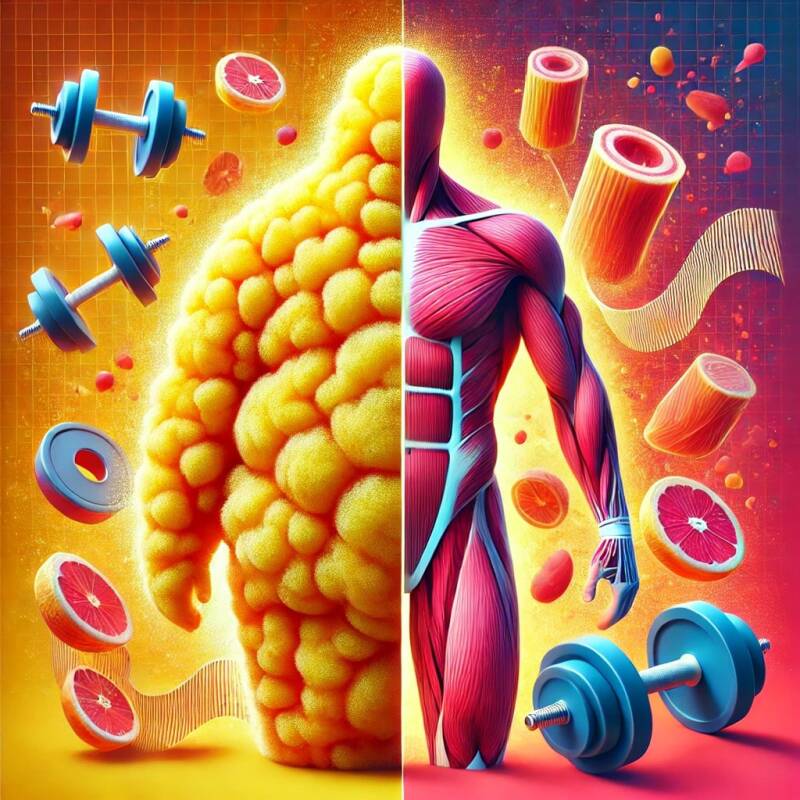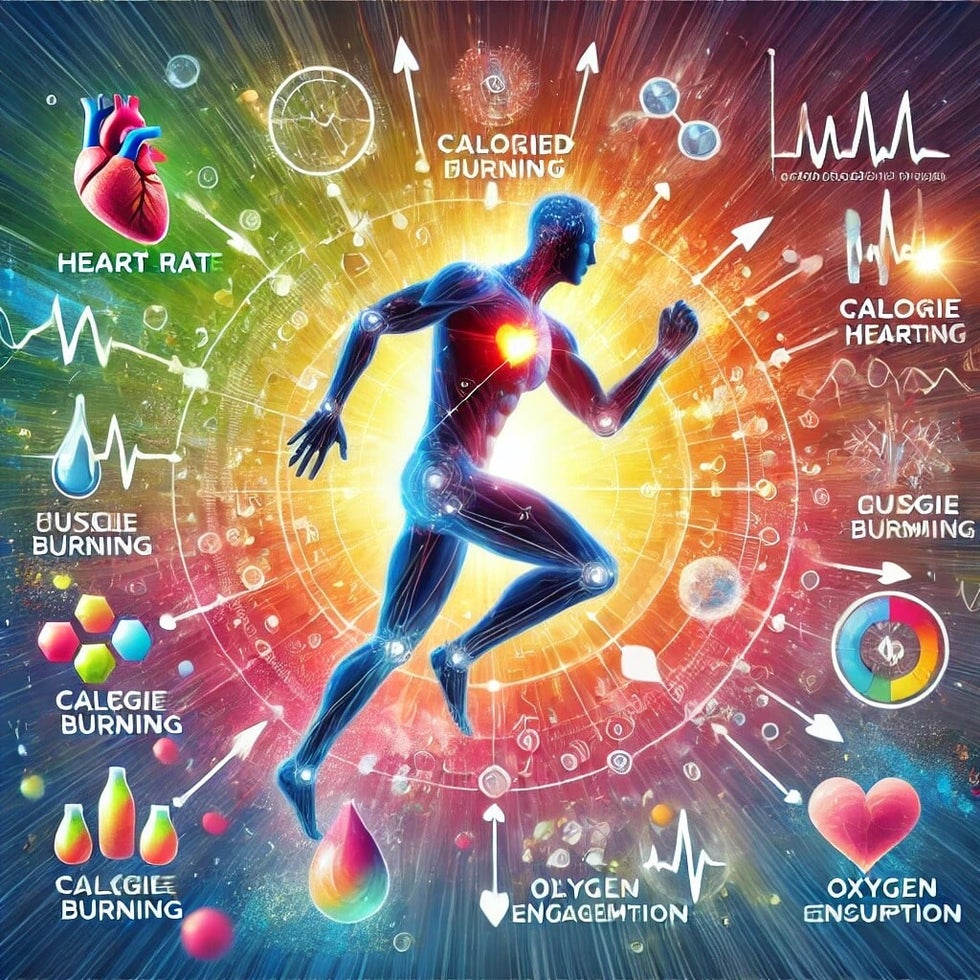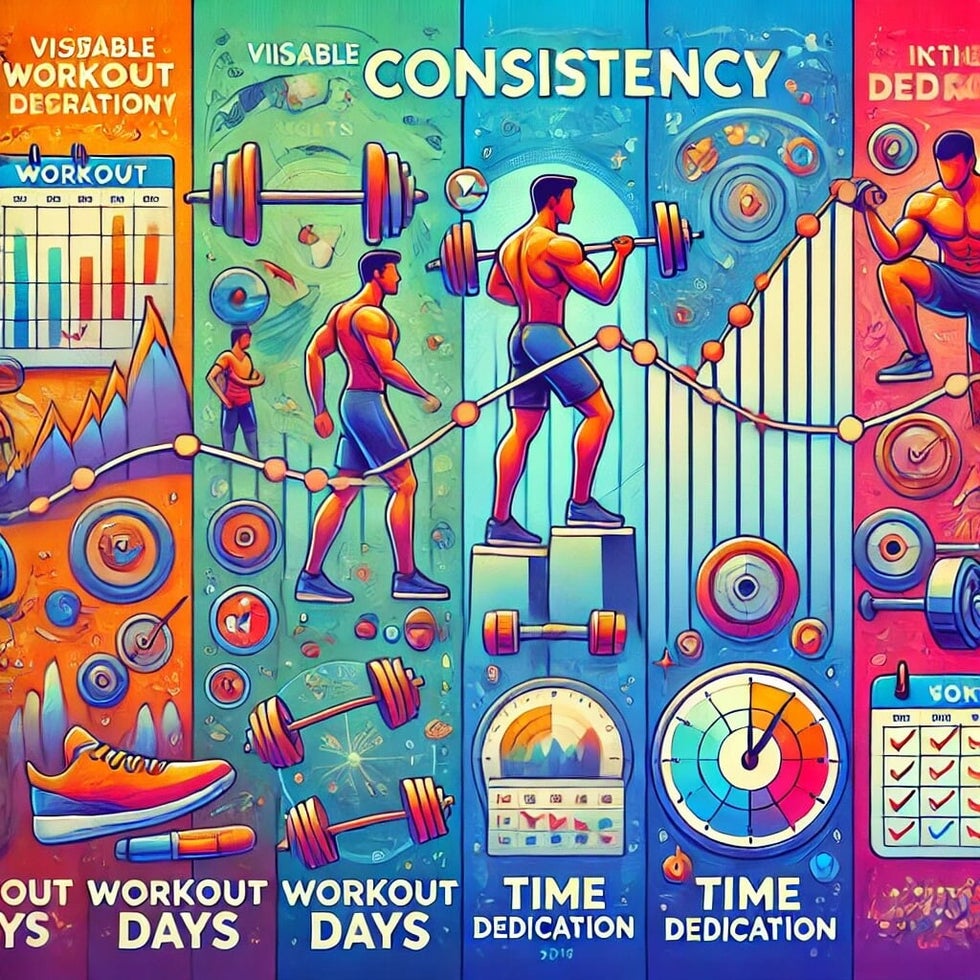When it comes to fitness, there's a common myth that tends to confuse many people: does fat turn into muscle when you exercise?
This belief is so prevalent that it has become a staple of gym conversations and fitness blogs alike. The allure of transforming unwanted fat into sleek muscle is enticing. After all, who wouldn't want to achieve that dream physique effortlessly? But what’s the reality behind this myth?

Understanding this concept is crucial, especially if you’re on a fitness journey. Many individuals strive for body transformation, aiming to shed fat while gaining muscle. The truth is, believing that fat can magically convert into muscle can lead to frustration and unrealistic expectations. So, what really happens in our bodies when we exercise?
In this blog post, we will explore the science behind fat loss and muscle gain, debunk common misconceptions, and provide you with actionable insights that can truly transform your workouts and approach to fitness. Are you ready to discover the truth? Let’s dive in!
Understanding Fat and Muscle: The Basics
What is Fat?
Fat is a type of nutrient that plays several vital roles in the body. It serves as a primary energy source, aids in the absorption of essential vitamins, and provides insulation and protection to our organs. Body fat is composed of adipose tissue, which stores energy for later use. There are different types of fat in the body:
- Subcutaneous fat: This is the fat stored just beneath the skin and is often what people refer to when discussing weight loss.
- Visceral fat: This fat surrounds internal organs and can pose health risks if present in excessive amounts.
While having some body fat is normal and necessary for health, excess fat can lead to various health problems, including heart disease and diabetes. Understanding the role of fat in the body is essential as we explore the relationship between fat and muscle.
What is Muscle?
Muscle tissue, on the other hand, is responsible for movement, maintaining posture, and producing heat in the body. It’s made up of long, fibrous cells that can contract and relax. There are three types of muscle tissue:
- Skeletal muscle: This type is attached to bones and allows voluntary movement.
- Cardiac muscle: Found only in the heart, this muscle works involuntarily to pump blood.
- Smooth muscle: Located in the walls of hollow organs, such as the intestines and blood vessels, it also works involuntarily.
When people discuss building muscle, they usually refer to skeletal muscle, which is what we develop through resistance training and exercise. The more muscle mass you have, the higher your resting metabolic rate, meaning you burn more calories even at rest.
How Does the Body Utilize Fat and Muscle?
The body’s ability to utilize fat and muscle effectively is vital for overall health and fitness. When you engage in physical activity, your body burns calories from two primary sources: carbohydrates and fat.
- During high-intensity workouts, your body relies more on carbohydrates stored in muscles for quick energy.
- In lower-intensity activities, such as walking or light jogging, the body tends to burn a higher percentage of fat for fuel.
To achieve fat loss while gaining muscle, a balanced approach is necessary. This usually involves a combination of aerobic exercises, strength training, and proper nutrition.
Understanding the interplay between fat and muscle can empower you on your fitness journey. It’s not about one transforming into the other but rather about achieving a healthier body composition through mindful choices.
The Science Behind Fat and Muscle Transformation
Does Fat Turn into Muscle?
To answer the burning question, does fat turn into muscle when you exercise? The short answer is: no, fat does not turn into muscle.
This myth likely stems from the way we often discuss body composition. When you lose fat through exercise and proper diet, you can gain muscle at the same time, but these processes occur independently. Fat and muscle are distinct types of tissues with different functions and characteristics.
When you engage in regular exercise, particularly strength training, your body undergoes several changes:
- Fat Loss: When you create a caloric deficit (burning more calories than you consume), your body starts to utilize stored fat for energy. This is why regular exercise, and a balanced diet are crucial for weight loss.
- Muscle Gain: When you lift weights or engage in resistance training, you create tiny tears in your muscle fibers. As your body repairs these tears, it builds new muscle tissue, increasing muscle size and strength. This process is known as muscle hypertrophy.
What Happens During Exercise?
Understanding what happens during exercise can clarify why fat does not turn into muscle. During physical activity, your body goes through several metabolic processes:
- Energy Utilization: Initially, your body will use glycogen (stored carbohydrates) for quick energy. As the workout continues, especially in longer sessions, your body shifts to burning fat for fuel.
- Hormonal Changes: Exercise induces hormonal changes that promote fat breakdown and muscle synthesis. For example, increased levels of human growth hormone (HGH)and testosterone during exercise help promote muscle growth.
- Post-Workout Effects: After a workout, your body enters a recovery phase. During this time, the body repairs and builds muscle tissue while also continuing to burn calories, sometimes for several hours post-exercise. This is known as the afterburn effector excess post-exercise oxygen consumption (EPOC).

What is the Role of Caloric Deficit?
A caloric deficit is crucial for fat loss. When you consume fewer calories than your body requires to maintain its weight, your body starts to use its fat stores for energy. This process can be broken down into a few key points:
- Weight Loss: A sustainable caloric deficit leads to weight loss, which often results in fat loss over time.
- Muscle Maintenance: While in a caloric deficit, it is essential to consume adequate protein and engage in strength training to help preserve muscle mass.
- Balanced Approach: Striking a balance between caloric intake and energy expenditure is vital. Too severe a deficit can lead to muscle loss, while too little exercise can prevent effective fat loss.
What is Hypertrophy?
Muscle hypertrophy refers to the process of increasing muscle size through exercise, primarily through resistance training. Here’s how it works:
- Mechanical Tension: Lifting heavy weights creates tension in muscle fibers, signaling your body to adapt and grow stronger.
- Muscle Damage: Small tears in muscle fibers during exercise stimulate repair mechanisms that lead to muscle growth.
- Metabolic Stress: Engaging in high-repetition training can cause metabolic stress within the muscles, contributing to hypertrophy.
Understanding hypertrophy is crucial because it emphasizes that building muscle requires a specific type of training and nutrition strategy that differs from fat loss.
Common Misconceptions About Fat and Muscle
Can You “Spot Reduce” Fat?
One prevalent misconception in fitness is the idea of spot reduction—the belief that you can lose fat in specific areas of your body by targeting them with exercises. For instance, many people do countless sit-ups in hopes of losing belly fat.
However, scientific research shows that spot reduction is largely a myth. When you lose fat, it occurs throughout your body based on genetics, hormonal balance, and overall body composition.
While targeted exercises can strengthen specific muscles, they won't eliminate fat in that area. Instead, a comprehensive approach that includes a combination of cardio, strength training, and a healthy diet is necessary for overall fat loss.
What Do People Get Wrong About Weight Training?
Another common misconception is that weight training will make you bulky or that it directly converts fat into muscle. This belief often discourages individuals from incorporating strength training into their routines.
The truth is, weight training can help you build lean muscle mass, which can increase your metabolism and assist in fat loss.
For most individuals, especially women, it is challenging to gain significant muscle mass without a specific training and nutrition regimen focused on hypertrophy.
Instead, strength training will tone your muscles, enhance your physique, and improve your overall strength and endurance.
Does Losing Fat Mean Gaining Muscle?
While it’s possible to lose fat and gain muscle simultaneously, they are not guaranteed to occur at the same rate. A few key points to consider:
- Body Composition Changes: As you lose fat, your muscle-to-fat ratio improves, which can make your physique look more toned even if you are not significantly increasing muscle mass.
- Nutritional Strategies: Adequate protein intake is essential for muscle growth, especially when in a caloric deficit. This helps ensure that the weight lost is primarily fat, not muscle.
- Training Focus: Incorporating a mix of both resistance training and cardiovascular workouts will optimize fat loss while promoting muscle gain.
Understanding these misconceptions can help clear up confusion and guide your fitness journey toward realistic and achievable goals.
For more detailed insights on the concept of spot reduction and its misconceptions, check out this article on Healthline.
The Role of Exercise in Body Composition
What Types of Exercise Help with Fat Loss?
When considering the best types of exercise for fat loss, it’s essential to recognize that both aerobic and anaerobic exercises play significant roles.
- Aerobic Exercise: This type includes activities such as running, cycling, swimming, and brisk walking. These exercises increase your heart rate and burn calories, making them effective for fat loss. For example, a 155-pound person can burn approximately 298 calories in 30 minutes of running at a moderate pace.
- Anaerobic Exercise: This primarily involves resistance training, which helps build muscle. While anaerobic workouts may burn fewer calories during the session compared to aerobic exercises, they lead to increased muscle mass, which in turn elevates your resting metabolic rate. This means you'll burn more calories at rest, contributing to overall fat loss.
How Important is Strength Training?
Strength training is vital for those looking to change their body composition. Here’s why:
- Increases Muscle Mass: As mentioned, building muscle enhances your metabolism, helping you burn more calories even when not exercising.
- Improves Insulin Sensitivity: Weight training can improve insulin sensitivity, which helps regulate blood sugar levels and promotes fat loss.
- Enhances Functional Fitness: Building strength improves your ability to perform daily activities, reducing the risk of injury and improving overall quality of life.
- Boosts Confidence: Progressing in strength training can boost self-esteem and motivation, helping you stick to your fitness journey.
To reap these benefits, aim for at least two to three sessions of strength training per week, focusing on all major muscle groups.
What is the Importance of Consistency in Workouts?
Consistency is key in any fitness regimen. It’s not about how intensely you work out once in a while, but how regularly you maintain your exercise routine. Here are a few reasons why consistency is crucial:
- Progress Over Time: Regular workouts contribute to gradual improvements in strength, endurance, and overall fitness, leading to significant changes in body composition over time.
- Habit Formation: Making exercise a consistent part of your routine helps develop a habit, making it easier to maintain a healthy lifestyle.
- Mental Well-being: Regular exercise has been shown to improve mood and reduce stress levels, further motivating you to continue your fitness journey.

Creating a Balanced Workout Routine
To effectively combine fat loss and muscle gain, consider creating a balanced workout routine that includes:
- 3-4 days of aerobic exercise(like jogging, cycling, or swimming).
- 2-3 days of strength training, focusing on compound movements such as squats, deadlifts, and bench presses.
- 1-2 days of flexibility and recovery exercises, such as yoga or stretching.
Incorporating variety into your workouts can help prevent boredom and keep you engaged, making it easier to stick to your goals.
For more information on the benefits of strength training and how to incorporate it into your routine, check out this article on Isometric Exercise: Benefits, Comparison, and How to Integrate into Your Routine.
Nutrition and Its Impact on Fat and Muscle
How Does Diet Influence Fat Loss and Muscle Gain?
Nutrition plays a pivotal role in achieving your fitness goals. The foods you consume provide the building blocks for muscle repair and growth while also influencing your body’s ability to burn fat. Here are key nutritional components to consider:
- Macronutrients: The three macronutrients—proteins, carbohydrates, and fats—must be balanced in your diet.
- Proteins: Essential for muscle repair and growth, aim for a daily intake of 1.2 to 2.2 grams of protein per kilogram of body weight, depending on your activity level. Sources include lean meats, fish, eggs, dairy, legumes, and nuts.
- Carbohydrates: Your body’s primary energy source, carbohydrates are vital for fueling workouts. Opt for complex carbs like whole grains, fruits, and vegetables, which provide sustained energy.
- Fats: Healthy fats (like avocados, nuts, and olive oil) are crucial for hormone production and nutrient absorption. Aim to include them in moderation.
- Micronutrients: Vitamins and minerals support metabolic processes, immune function, and overall health. Ensure you consume a variety of colorful fruits and vegetables to meet your micronutrient needs.
3. Hydration: Staying hydrated is crucial for performance and recovery. Water helps transport nutrients to cells, lubricates joints, and aids in digestion. Aim for at least 8-10 cups of water daily, adjusting based on activity level and climate.
What Role Does Protein Play?
Protein is often hailed as the king of macronutrients when it comes to muscle gain. Here’s why it’s so essential:
- Muscle Repair: After exercise, protein helps repair and rebuild muscle fibers that experience micro-tears during strength training.
- Satiety: High-protein diets can enhance feelings of fullness, potentially aiding in weight management by reducing overall calorie intake.
- Thermic Effect of Food (TEF): Digesting protein burns more calories than fats or carbohydrates, contributing to a higher metabolic rate.
To maximize muscle gain, consider incorporating a source of protein in every meal and snack, especially after workouts.
Should You Be in a Caloric Deficit or Surplus?
The answer to whether you should be in a caloric deficit or surplus depends on your goals:
- Caloric Deficit for Fat Loss: If your primary aim is to lose fat, a moderate caloric deficit is essential. This means consuming fewer calories than your body needs to maintain its current weight. A deficit of 500 to 750 calories per day can lead to a sustainable fat loss of about 1-1.5 pounds per week.
- Caloric Surplus for Muscle Gain: If you’re looking to build muscle, a slight caloric surplus may be beneficial. This allows your body to have enough energy to support new muscle growth. Aim for an additional 250 to 500 calories per day, focusing on nutrient-dense foods.
- Recomposition Approach: Some individuals aim to lose fat while gaining muscle simultaneously (recomposition). This can be tricky but is possible with the right balance of exercise, nutrition, and protein intake.
Understanding your body’s needs and adjusting your caloric intake based on your goals is essential for success.
Real-Life Applications and Success Stories
What Does a Balanced Fitness Routine Look Like?
Creating a balanced fitness routine that effectively incorporates both fat loss and muscle gain is essential for achieving your goals. Here’s a sample weekly workout plan that highlights a variety of exercises:
| Day | Activity | Focus |
|---|---|---|
| Monday | 30 min Cardio (Running or Cycling) | Fat Loss |
| Tuesday | Full Body Strength Training | Muscle Gain |
| Wednesday | 30 min HIIT (High-Intensity Interval Training) | Fat Loss |
| Thursday | Upper Body Strength Training | Muscle Gain |
| Friday | 30 min Cardio (Swimming or Rowing) | Fat Loss |
| Saturday | Lower Body Strength Training | Muscle Gain |
| Sunday | Rest or Yoga | Recovery |
Key Components of a Balanced Routine:
- Cardiovascular Training: Aim for at least 150 minutes of moderate-intensity aerobic activity per week. This can include activities like brisk walking, cycling, or swimming, all of which help burn calories and improve heart health.
- Strength Training: Include at least two days of strength training for all major muscle groups. Focus on compound movements such as squats, deadlifts, bench presses, and rows to maximize muscle engagement and growth.
- Flexibility and Recovery: Don’t forget to incorporate flexibility exercises, such as yoga or stretching, to maintain mobility and reduce injury risk. Rest days are equally important for recovery and muscle growth.
Key Takeaways
As we wrap up our exploration of the relationship between fat and muscle, let's summarize the main points to help solidify your understanding and empower your fitness journey.
Key Points to Remember:
- Fat Does Not Turn into Muscle: It's essential to understand that fat and muscle are two distinct types of tissue. Fat does not convert into muscle; rather, fat loss and muscle gain can occur simultaneously through proper training and nutrition.
- Create a Caloric Deficit for Fat Loss: To lose fat, you need to burn more calories than you consume. A moderate caloric deficit, combined with regular exercise, will promote fat loss while preserving muscle mass.
- Incorporate Both Cardio and Strength Training: A balanced fitness routine that includes cardiovascular exercise for fat loss and strength training for muscle gain is key to changing your body composition.
- Focus on Nutrition: Adequate protein intake is crucial for muscle repair and growth. Pay attention to your macronutrients and ensure you're consuming a balanced diet rich in whole foods.
- Stay Consistent: Consistency is the cornerstone of any successful fitness plan. Regular workouts and a sustainable approach to nutrition will yield the best results over time.
Actionable Steps You Can Take:
- Set Realistic Goals: Define your fitness goals, whether it's losing fat, gaining muscle, or both, and create a plan that works for you.
- Track Your Progress: Keep a workout log and monitor your dietary intake. Tracking helps you stay accountable and makes it easier to identify what works.
- Mix It Up: Avoid workout plateaus by regularly changing your routine. Introduce new exercises, switch up your cardio, or adjust your weights to keep things fresh.
- Listen to Your Body: Pay attention to how your body responds to workouts and nutrition. Make adjustments as needed to ensure you're progressing and not risking injury.
- Stay Educated: Read articles, listen to podcasts, and engage with fitness communities to stay informed and motivated on your journey.
By focusing on these key takeaways, you can create a path that leads to lasting results, helping you achieve the body composition you desire.
Your Journey to a Healthier You
In conclusion, understanding the relationship between fat and muscle is essential for anyone embarking on a fitness journey. The myth that fat can turn into muscle can lead to confusion and disappointment.
Instead, focus on the fact that while fat loss and muscle gain are separate processes, they can be achieved simultaneously through a well-rounded approach that combines effective exercise, proper nutrition, and consistency.

Why It’s Important to Focus on Overall Health
While achieving an ideal body composition is often a goal, it's crucial to remember that overall health and well-being should always come first. This means not only focusing on numbers on a scale but also considering factors like:
- Physical Fitness: Being strong and capable in daily activities.
- Mental Well-being: Recognizing the positive impact of exercise on mood and mental health.
- Sustainable Lifestyle: Creating healthy habits that you can maintain long-term rather than quick fixes that may not last.
Encouragement for Your Fitness Journey
Every individual’s journey is unique, and there will be challenges along the way. Remember that setbacks are normal, and progress isn’t always linear. Stay motivated by celebrating small victories, whether that’s lifting heavier weights, fitting into a favorite pair of jeans, or simply feeling more energetic throughout the day.
Don’t hesitate to reach out to fitness communities or professionals for support. Surrounding yourself with encouragement can make all the difference in staying committed to your goals.
Final Thoughts
As you move forward, keep in mind that your body is capable of incredible transformations. By understanding the science behind fat loss and muscle gain, and by implementing the strategies discussed in this article, you’re well-equipped to embark on a successful fitness journey.
Now, go out there and make your workouts count!
If you’ve enjoyed this exploration into whether fat turns into muscle when you exercise, you’re not alone in seeking clarity on this topic. Knowledge is power, and understanding the truth about fat loss and muscle gain is a crucial step in achieving your fitness goals.
What to Do Next:
- Join the Conversation: Share your thoughts or experiences in the comments below! Have you struggled with the concept of fat turning into muscle? What strategies have worked for you in your fitness journey? Your insights could help others who are on a similar path.
- Explore More Resources: For additional reading, check out our related posts on topics such as diet and nutrition and the best, exercises for fat loss. Knowledge is the key to progress!
Final Encouragement
Remember, your journey towards a healthier you is unique, and every step you take is significant. Focus on building healthy habits, embrace the process, and celebrate your achievements, no matter how small they may seem.
You have the power to change your body and your life—keep pushing forward!
Thank you for joining us in this discussion about the relationship between fat and muscle. We hope this information inspires you to take actionable steps toward your health and fitness goals!
If you have any further questions or topics you’d like to see covered, feel free to reach out. We’re here to support you every step of the way!
Sucks out 1.3 lbs. per day? Eat this before breakfast!
One woman lost 9 lbs. in just the first week…
And all they did was eat this odd "dessert" food before breakfast.
It can even prevent deadly, obesity-related heart attacks.
The best part?
Folks are seeing life-changing results – FAST.
This unusual "dessert" food is helping men and women easily shed pounds of fat, cut cravings, and hit their goal weight almost effortlessly…
And you can too.







Add comment
Comments